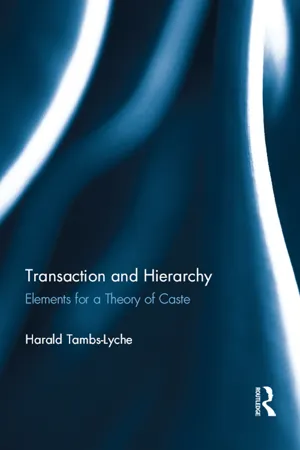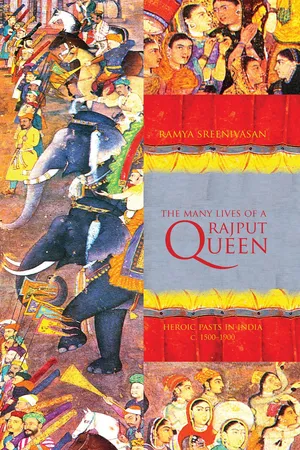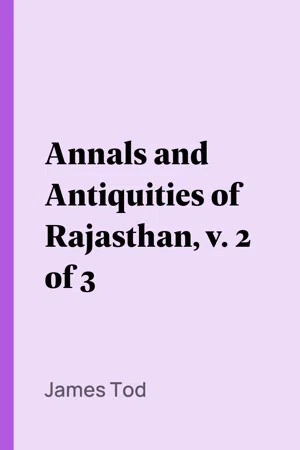History
Rajput Kingdoms
The Rajput Kingdoms were a collection of Hindu kingdoms in medieval India, known for their warrior traditions and valor. They emerged in the 6th century and played a significant role in Indian history, resisting foreign invasions and preserving Hindu culture. The Rajput rulers were known for their chivalry, martial prowess, and patronage of art and architecture.
Written by Perlego with AI-assistance
Related key terms
3 Key excerpts on "Rajput Kingdoms"
- eBook - ePub
Transaction and Hierarchy
Elements for a Theory of Caste
- Harald Tambs-Lyche(Author)
- 2017(Publication Date)
- Routledge(Publisher)
31Such a system had no place for ‘divine’ kings, and divinity rested squarely with the chiefs’ goddesses, seen as the arbitrators of political fortunes as well as the ultimate guardians of dharma—the moral order—that the chiefs were supposed to uphold. The chiefs’ halo came from the warlike exploits of their forefathers, as well as their own reputation. The pedigree and renown of such a ruler is secular, not sacred.A very different situation appears in central areas during the same period. In the extreme case the king is seen as an incarnation of the deity, or of such sacred figures as the Bodhisattvas. The latter is usually the case for the Buddhist king, whose sacredness is seen as permanently inherent in his status: the actions that earns the fame of a Rajput are not expected from the Buddhist ruler, some of whom, like Thibaw of Burma, have been described as ‘prisoners in their palace’, as other powerful figures did the (dirty?) political work for them.Buddhist rulers are long gone from India, but they may have furnished the model for the Buddhist monarchies of Southeast Asia. In India itself, however, this royal model persisted in the Vishnudharmottara Purana and other early medieval texts (c. A.D . 700-1200) (Inden 1978). Here, the king is ‘a microcosm of the Cosmic Man’.32 This divine aspect is visible in some Hindu kingdoms, and the king of Puri, the overlord of medieval Orissa, seems quite close to the Buddhist type of divine king. He was seen as an incarnation of Vishnu, through the intermediary figure of Jagannath. His kingdom was closely integrated with Jagannath’s temples and as the god’s servant the king participated in divine authority.33 According to Kulke, this form of kingship was largely a reaction to the problems of keeping a multi-centric, loosely organized kingdom together, by introducing a new source of authority to supplement inadequate organizational and military resources (Kulke 1978: 147-50).34 - eBook - ePub
The Many Lives of a Rajput Queen
Heroic Pasts in India, c. 1500-1900
- Ramya Sreenivasan(Author)
- 2015(Publication Date)
- University of Washington Press(Publisher)
c . 1660) is particularly revealing of the diverse contexts from which anti-imperial polemics could emerge in the seventeenth century, and of their differing hues.Kings, Chiefs, and Queens: Rajasthan c . 1500–1750The Rajput Kingdoms of Rajasthan witnessed increasing attempts to consolidate monarchical power from the sixteenth century. The inherited rights and entitlements of the major lineage chiefs were frequently incompatible with new assertions of royal authority. Elite polygyny provided an alternative to rulers in this period: military resources and a network of alliances, to be used both against refractory chiefs and in the service of Mughal imperial expansion. Throughout the period, however, these structural features of Rajput polity threatened its ruling lineages as much as Mughal expansion did.When the Rathors of Marwar initially established their control over Jodhpur in the mid-fifteenth century, the ruler’s “sons and brothers . . . were allowed to occupy the various territories [they] conquered” as their “estates” (thikana ), under the practice of bhai-bant (division among brothers).9 In the mid-sixteenth century, the Jodhpur ruler renegotiated his relationships with his clansmen and chiefs. Seeking to assert that a chief “was dependent for his position on the good-will of the Raja rather than on his inherent rights,” he began the practice of assigning land-revenue grants (patta ) to the chiefs in exchange for service. The assignment of new lands to chiefs, in a period of territorial expansion through conquest, had contradictory consequences. On the one hand the chiefs were more willing to accept their new, contractual relations with the king because of the immediate gains. On the other hand the extended kinship network was implicated in the kingdom’s territorial expansion, and kinship ties continued to guarantee status and access to entitlements.10 The new revenue grantees still belonged to the monarch’s extended clan and still claimed rights over patrimonial domains.11 - eBook - ePub
Annals and Antiquities of Rajasthan, v. 2 of 3
or the Central and Western Rajput States of India
- James Tod, William Crooke, (Authors)
- 2018(Publication Date)
- Perlego(Publisher)
They formed of their own body a guard of honour for the person of the prince, one half remaining on duty in the castle, the other half being in the town below. While the Raja would lament the distracted state of his country, the inroads of the hill tribes, and the depredations of his own chiefs, Devi Singh of Pokaran would reply, “Why trouble yourself about Marwar? it is in the sheath of my dagger.” The young prince used to unburthen his griefs to his foster-brother Jaga, a man of caution and experience, which qualities he instilled into his sovereign. By dissimulation, and an apparent acquiescence in their plans, he not only eluded suspicion, but, availing himself of their natural indolence of character, at length obtained leave not only to entertain some men of Sind as guards for the town, but to provide supplies for their subsistence: the first approximation towards a standing mercenary force, till then unknown in their annals [128]. We do not mean that the Rajput princes never employed any other than their own feudal clans; they had foreign Rajputs in their pay, but still on the same tenure, holding lands for service; but never till this period had they soldiers entertained on monthly stipend. These hired bands were entirely composed of infantry, having a slight knowledge of European tactics, the superiority of which, even over their high-minded cavaliers, they had so severely experienced in their encounters with the Mahrattas. The same causes had operated on the courts of Udaipur and Jaipur to induce them to adopt the like expedient; to which, more than to the universal demoralization which followed the breaking up of the empire, may be attributed the rapid decay of feudal principles throughout Rajputana. These guards were composed either of Purbia [16] Rajputs, Sindis, Arabs, or Rohillas
Index pages curate the most relevant extracts from our library of academic textbooks. They’ve been created using an in-house natural language model (NLM), each adding context and meaning to key research topics.


